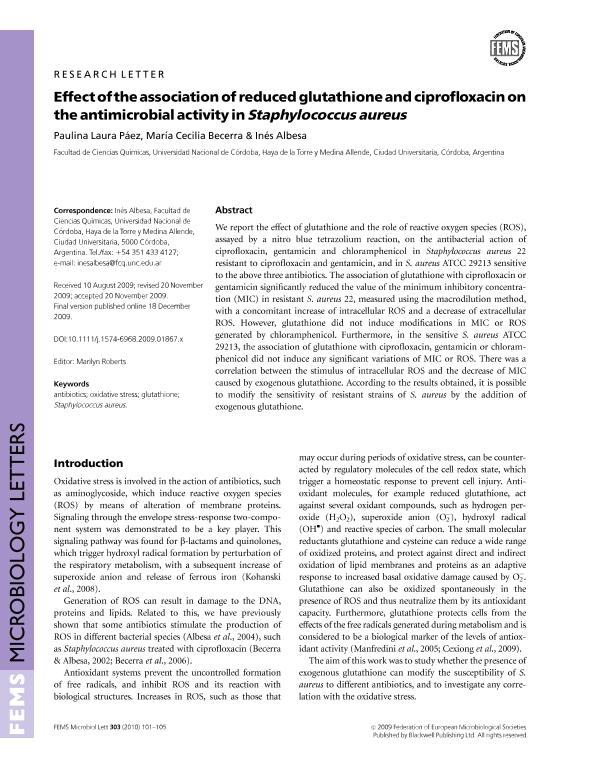Artículo
Effect of the association of reduced glutathione and ciprofloxacin on the antimicrobial activity in Staphylococcus aureus
Fecha de publicación:
02/2010
Editorial:
Oxford University Press
Revista:
FEMS Microbiology Letters
ISSN:
0378-1097
e-ISSN:
1574-6968
Idioma:
Inglés
Tipo de recurso:
Artículo publicado
Clasificación temática:
Resumen
We report the effect of glutathione and the role of reactive oxygen species (ROS), assayed by a nitro blue tetrazolium reaction, on the antibacterial action of ciprofloxacin, gentamicin and chloramphenicol in Staphylococcus aureus 22 resistant to ciprofloxacin and gentamicin, and in S. aureus ATCC 29213 sensitive to the above three antibiotics. The association of glutathione with ciprofloxacin or gentamicin significantly reduced the value of the minimum inhibitory concentration (MIC) in resistant S. aureus 22, measured using the macrodilution method, with a concomitant increase of intracellular ROS and a decrease of extracellular ROS. However, glutathione did not induce modifications in MIC or ROS generated by chloramphenicol. Furthermore, in the sensitive S. aureus ATCC 29213, the association of glutathione with ciprofloxacin, gentamicin or chloramphenicol did not induce any significant variations of MIC or ROS. There was a correlation between the stimulus of intracellular ROS and the decrease of MIC caused by exogenous glutathione. According to the results obtained, it is possible to modify the sensitivity of resistant strains of S. aureus by the addition of exogenous glutathione.
Palabras clave:
Antibiotics
,
Oxidative Stress
,
Glutathione
,
Staphylococcus Aureus
Archivos asociados
Licencia
Identificadores
Colecciones
Articulos(IMBIV)
Articulos de INST.MULTIDISCIPL.DE BIOLOGIA VEGETAL (P)
Articulos de INST.MULTIDISCIPL.DE BIOLOGIA VEGETAL (P)
Citación
Páez, Paulina Laura; Becerra, María Cecilia; Albesa, Inés; Effect of the association of reduced glutathione and ciprofloxacin on the antimicrobial activity in Staphylococcus aureus; Oxford University Press; FEMS Microbiology Letters; 303; 1; 2-2010; 101-105
Compartir
Altmétricas




